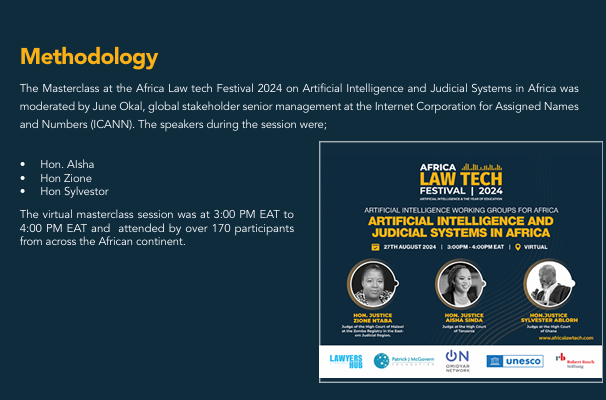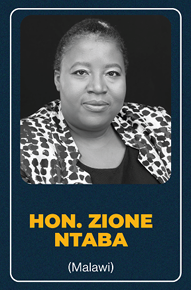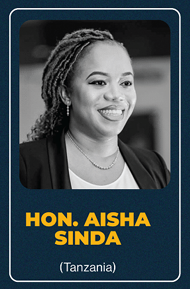There is no doubt that Artificial Intelligence is taking shape in various sectors and industries around the world. AI has become the linchpin of innovation, streamlining processes, and redefining standards. From healthcare to finance, logistics to manufacturing. As of 2023, over 80% of companies worldwide reported using AI to enhance their business operations with a recent Statista survey revealing that every industry utilizes approximately 20% of AI functions. The judicial sector is no exception. Many judiciaries around the world have started to slowly implement these AI technologies and algorithms into their judicial systems. In Africa, the adoption and integration of AI systems has been slow but progressive as only 2 african countries, Morocco and Tanzania, have developed and integrated some form of AI systems into their judicial systems. This slow but progressive integration formed part of this masterclass. As outlined by the moderators, the session was centered around AI systems and what that looks like, especially in the frame and with a background of judicial systems.

Session Overview
Artificial Intelligence impact in the judiciary
Justice institutions in Africa, though progressive, have been slower to adopt technology intensively. However, the advent of the COVID-19 pandemic accelerated the adoption and integration of technology in judicial systems, not only in Africa but globally. This shift includes the use of virtual courts, e-filing systems, case management systems, and more. With the rapid integration of AI in specific sectors, the judiciary is no exception. There is no doubt that AI has the potential to transform judicial processes in Africa
"AI is rapidly transforming various sectors, including the judicial system, covering everything from automating routine tasks to advanced data analytics. AI has the potential to enhance the efficiency, transparency, and fairness of judicial processes. However, its integration into judicial systems raises important questions around ethics, bias, accessibility, accountability, and the critical role human oversight must play."
June Okal
- Automating routine tasks thus alleviating the burden on judicial systems, reducing the time and resources needed to resolve simple cases.
- Additional benefits such as impartiality, objectivity, and the ability to minimize human error, helping to ensure consistency in legal outcomes. For example, AI can assist in reducing disparities in sentencing, avoiding disproportionate treatment in similar cases like bail settings or punishment decisions.
- Supporting judicial reasoning by analyzing large datasets, predicting case outcomes, and offering solutions based on historical precedents, the use of AI will.
- Enhancing efficiency and accuracy using tools such as litigation risk assessment systems, document drafting aids, and emotion recognition technologies.
- Handling minor disputes, such as small claims, tax disputes, and traffic violations, more effectively, making justice more accessible and affordable.
- Prioritize cases and allocate judicial resources more effectively, using AI-driven solutions, such as case filtering systems and predictive analytics, ensuring faster resolution times and improving the overall perception of fairness within the judicial system.
- Morocco has initiated the use of AI to transcribe rulings, conduct research, and retrieve archived texts. The country also plans to use AI for automatically recording and transcribing court sessions, addressing challenges related to the Darija dialect and the Amazigh language.
- Tanzania has introduced an AI-driven system for transcriptions and translations, designed to manage the diverse dialects of Kiswahili, spoken across Tanzania’s mainland and Zanzibar, as well as English. This system facilitates real-time, accurate translations and transcriptions.
- Egypt has announced plans to integrate an AI-powered speech-to-text transcription system in its courtrooms. This AI engine will automatically document court session records, enhancing the efficiency of transcript writing.
"The need for us to ensure that the AI incorporation is not only at that level at the High Court, or that upper bench level, but also moves down to the lower bench is quite critical and significant. But one of the things I also note is that the AI adoption in terms of African judiciaries is still fragmented because I think there has been no discussion on a continental level to get us to agree on what we can use."

"AI technologies are more skewed towards the higher courts, with the lower courts mainly piloting projects, and while there is growing acceptance of electronic systems and AI tools, the overall adoption remains slow and fragmented, with significant challenges in remote areas and uneven access to technology."

Hon Sylvester Ablorh

If AI systems are used for the predictive nature of sentencing guidelines, according to Hon. Zione, human oversight cannot be underplayed—it must still exist. As a former prosecutor, she highlights that criminal cases are often nuanced. Two seemingly similar incidents can differ greatly based on factors like the offender's age or whether the crime was committed alone or with others. These elements must be factored into the system, but some require human oversight to remind the court that sentencing is about the individual in front of them, not just generalized guidelines. Sentencing must be tailored to the crime and the offender, not solely based on predetermined ranges. It's crucial to avoid biases, and the diversity of the team developing AI for sentencing plays a critical role in ensuring fairness. Sentencing must consider both the offender and the victim, and while AI can aid the process, human judgment remains essential to ensure justice is served.
Hon Aisha Sinda

According to Hon. Aisha, leveraging AI in the judicial system will help judges prioritize cases based on potential violations or other relevant factors, which could expedite the decision-making process and reduce delays. However, the ethical concerns, such as bias in AI systems, must be carefully addressed. To minimize risks to the communities served, Hon. Aisha advocates for the promotion of effective regulation in this area. Such regulation is essential to ensure that AI technologies are used responsibly and equitably in the justice system.
Participants session interactions
Rachel Magege posed an important question concerning the court staff and officers, including clerks and other members working within the judiciary. She inquired about the extent of capacity building being implemented for these personnel in relation to AI. With the integration of AI into the court system, Magege asked whether there are concerns about job displacement or if measures are being taken to ensure that current positions are maintained.
In response to Racheal Magege's question, Hon. Sylvester addressed the issue of capacity building for court staff in Ghana with the adoption of new technologies like artificial intelligence. He explained that when a new system or process is introduced, there is typically a phased approach to training, starting with a few judges and gradually extending to the broader court staff. However, challenges arise with the general adoption of technology due to the large number of staff and the extended time required for nationwide training. The process is slow and costly, and training is often rolled out in phases, which contributes to the overall sluggish pace of digital system adoption. Despite the comprehensive approach to capacity building, the implementation of these systems remains gradual.
Hon Sylvester Ablorh

Hon Zione, in response to Magege’s question, highlighted the often-overlooked aspect of capacity building for court clerks and administrative staff. Pointing out that clerks, who handle much of the judiciary's administrative work, are typically trained last, receiving the least resources, while the majority of resources are prioritized for judges. This top-down approach, common in many government institutions, leaves the most critical staff without adequate support.
Judge Zione shared her experience during COVID-19, where she had to personally teach her court clerks how to use Zoom and teleconferencing tools, underscoring the lack of structured training for these essential staff members. Capacity building, according to her, shouldn’t stop at the top, and judges themselves must take the initiative to ensure their teams are equipped with the skills needed for new technologies. In her view, true innovation in the judiciary requires leaders to actively involve and train the entire court staff, not just those at the higher levels.
In agreement with Magege’s concerns, Hon Aisha acknowledged concerns about AI leading to job displacement within the judiciary. While AI has the potential to automate tasks traditionally performed by clerks, such as in Tanzania’s case management system, the impact on judges has been relatively limited. Judges are now handling tasks that were once managed by clerks, reducing the need for certain roles. Many senior judges struggle to adapt to AI technologies due to a lack of technical expertise. To address this, Hon. Aisha outlined the need for law schools and educational institutions to offer specialized programs in AI, legal technology, and project management to equip future legal professionals with the necessary skills to navigate the evolving judicial landscape.
Are we truly ready as judicial systems
Quincey Otieno also asked whether we are truly ready as a judicial system, or as the judicial side of the profession, to embrace AI systems that can, from the onset, render decisions. He questioned if it is possible for AI to assist throughout the entire process, from the initiation of a case all the way to delivering a judgment. Furthermore, he inquired about the potential uptake or reception of using AI systems to render decisions or summarize court texts and documents.
In answer to the question, Hon. Zione provided a detailed perspective on the use of AI in the judicial system, particularly in alternative dispute resolution (ADR) methods like arbitration and mediation. She explained the fundamental difference between the two processes: In arbitration, one side is generally looking for a clear victory, while in mediation, the goal is a win-win outcome for both parties. Mediation, she pointed out, requires a level of human nuance, as it involves negotiations between two parties. This human element cannot be entirely replaced by AI.
However, AI could play a valuable role in offering reasoned outputs and suggesting possible options. AI's ability to analyze vast amounts of data and explore parameters that may have been overlooked can be particularly useful. For instance, in both arbitration and mediation, AI could provide insights into potential outcomes, helping parties better understand the full scope of their options. But she drew a firm line when it came to AI rendering the final decision, particularly in arbitration.
In arbitration, according to her, it is important to retain a human element in the decision-making process. Ultimately, an arbitrator must be held accountable for the decision, and this accountability cannot be passed to an AI system. The arbitrator is ethically responsible for ensuring impartiality and fairness, and this responsibility remains, especially if the decision is later appealed. The arbitrator's judgment will be scrutinized for any potential bias or influence, something that cannot be delegated to AI.
In mediation, AI could still assist by providing reasonable suggestions for both parties to consider. However, the final decision must come from the parties themselves. AI can offer possible resolutions, but the mediated agreement must reflect human judgment and the will of the involved parties.
She finally underscored the larger issue of accountability in the judicial system. For judicial officers, AI can be a useful tool to support decision-making, but it cannot assume the ethical responsibilities that come with rendering final judgments. There is a need to strike a balance between using AI in the decision-making process and maintaining human oversight, especially in areas where impartiality and independence are essential.
Hon. Sylvester in answering the question shared his perspective on the role of AI in the judicial process. AI , according to him, should be viewed as a tool to assist, not replace, the decision-maker. While AI can help guide judges, mediators, or arbitrators in making decisions, the final responsibility always rests with the human involved. AI can provide useful insights and help identify important factors based on the information or data provided by the parties, but it is ultimately the human's responsibility to make the final judgment.
In some cases, a unique situation may arise that AI is not equipped to handle due to its reliance on existing data and patterns. If AI fails to capture the uniqueness of a case, it is still the judge, mediator, or arbitrator who must use their experience, knowledge, and judgment to make the most appropriate decision. This human element is critical, especially when a decision must be tailored to meet the specific needs of the parties involved.
While AI can be a helpful tool, particularly in ADR, the core responsibility of judging remains with human beings. AI can offer guidance and reference points, but it cannot replace the human ability to apply wisdom and experience to deliver a fair and just outcome. In expressing support for integrating AI into ADR, he noted that it can be a valuable resource when decision-makers need guidance or specific insights in challenging moments. However, AI should complement, not substitute, the role of the human decision-maker.
Hon. Aisha in answering the question, provided her perspective on the role of AI in judicial processes, particularly in mediation and arbitration. AI plays a supporting role, rather than taking over the decision-making process. AI offers new possibilities for resolving disputes more efficiently and effectively by assisting in tasks like predicting potential outcomes or analyzing data during negotiations. However, its role remains supplementary.
By taking care of the more technical aspects, AI allows mediators, arbitrators, and judges to focus on the human elements of the law. This includes empathy, advocacy, and the pursuit of justice—qualities that AI cannot replicate. According to her, while AI enhances the process, it is the human decision-makers who must lead with emotional intelligence and fairness.
In her view, AI's role in judicial settings is to streamline certain processes, enabling legal professionals to dedicate more attention to the human side of dispute resolution. This balance ensures that AI enhances efficiency without compromising the essence of justice and the human touch essential in legal decision-making.
Is it time to Regulate?
Quincey raised a follow-up question, asking whether it's time for the legal profession to establish clear rules governing the use and disclosure of AI in drafting legal documents and rendering decisions. Should AI be regulated as a tool in legal practice to ensure transparency and accountability?
In response to the question Hon. Zione strongly emphasized the need for clear policies and ethical boundaries around the use of emerging technologies, particularly AI. While other industries have adapted more swiftly to technological advancements, the legal profession has been slower to integrate these tools into its formal policies and guidelines. Technologies such as Zoom and Google Meet have become commonplace, yet the legal framework governing their use remains underdeveloped. This reluctance stems from the discomfort many legal professionals feel in acknowledging AI’s role in their work, fearing that disclosing its use might undermine the perceived human element of legal judgments.
Transparency in how AI is utilized, whether in summarizing case documents, aggregating issues, or drafting decisions, is crucial for maintaining trust in the legal system. Any judgment involving AI assistance must clearly indicate which parts were generated by AI versus human reasoning. This distinction is important for ensuring that legal judgments can be reviewed, appealed, and understood with full clarity.
In her view, the use of AI in the legal space must be accompanied by transparency and accountability, not just for the professionals involved but for the public they serve. There is indeed an urgent need for clear guidelines, if not formal policies, to govern AI’s role in the legal profession.
In addressing the question, Hon. Sylvester pointed out examples from judicial systems that have already integrated AI into their practices. They have implemented ethical rules requiring any lawyer, litigant, or judge who uses AI to disclose the AI tool and clearly indicate the extent of its contribution.
This transparency serves a key purpose: verification. While AI can be trusted to assist with legal tasks, the responsibility to verify the accuracy and appropriateness of AI-generated output still lies with the legal professional. Without disclosure, it becomes difficult to own the results produced by AI, leading to potential accountability issues.
The policies adopted by these countries could serve as a valuable model for other jurisdictions considering the integration of AI in legal practice. Some legal professionals are already honest about their use of AI, while others may not be, highlighting the need for a formal policy that mandates disclosure. This would ensure that AI’s role is transparent, and its impact can be verified by all parties involved.
In response Hon. Aisha noted that AI systems and tools can make errors or provide incorrect information, which can lead to serious consequences. Supervision is important particularly for judges and senior lawyers, who must oversee the use of AI by junior employees and legal practitioners. While AI can be a valuable tool, it requires careful oversight to ensure that its output is accurate and responsible.
Hon. Aisha agreed with the need for protective measures to safeguard citizens and businesses from the potential adverse effects of AI. This includes the promotion of effective regulations, data protection, and the confidentiality of sensitive information, particularly in relation to cybercrime and AI applications.
Revolutionizing Access to Legal Services
Hon. Zione shared a compelling vision of AI's role in democratizing access to legal services. In many regions, particularly in Africa, the court system remains highly centralized, making it challenging for individuals from remote or underserved areas to access legal assistance.
The utility of AI in addressing this issue by providing remote legal support. AI tools could offer preliminary legal explanations, simplify legal jargon, and prepare individuals for court proceedings before they even step into a courtroom. This proactive approach could significantly reduce the burden on legal professionals, who often spend extensive time explaining legal processes to unrepresented individuals.
Moreover, AI's potential to enhance accessibility for individuals with disabilities cannot be overstated. With limited resources such as sign interpreters or translation services available in many courtrooms, AI could bridge these gaps, offering real-time translations and other accommodations to ensure a fair and inclusive legal process.
Fostering Intergenerational Learning
The discussion also touched upon the dynamics between senior and junior legal professionals in integrating AI into their practices. Iddi Jumaa Kassi, one of the attendees, raised an important point about the openness of senior professionals to learning from their junior counterparts, particularly those more familiar with emerging technologies like AI. Hon. Zione and Hon. Sylvestor echoed this sentiment, advocating for a reciprocal learning environment where wisdom and experience from senior professionals meet the fresh perspectives and technological savvy of the younger generation.
Hon. Zione shared personal experiences, highlighting how learning from junior colleagues and staff members, regardless of their formal qualifications, has enriched their practice. This approach fosters a culture of continuous learning and adaptability, essential for navigating the rapidly evolving landscape of AI and technology.
According to Hon. Sylvestor, acknowledging the technological advancements of younger generations is crucial. Senior professionals should embrace the humility to recognize that their experience, while valuable, does not encompass all knowledge, especially in the face of new technological tools. This openness to learning and collaboration can enhance the overall efficiency and effectiveness of legal practices.
Conclusion
It is clear that Artificial Intelligence is here to stay and will become an integral part of our daily lives, including within the judicial system. As we move forward, our primary focus must be on how we regulate and harness AI for the betterment of our communities. This is not just about integrating new technologies, but about ensuring that they are used ethically and effectively to enhance our justice systems.
The masterclass discussion highlighted several key takeaways:
the importance of inclusivity in AI deployment to address issues of ethics, bias, and discrimination;
the need for ongoing capacity development across all levels involved in justice delivery; and
the recognition that AI should support, not replace, human judgment in the judicial process.
The integration of AI into the judicial system promises to enhance accessibility, streamline processes, and promote a more inclusive and responsive judiciary. By leveraging AI to reach marginalized communities and foster intergenerational learning, the judiciary can evolve to meet the demands of the modern era.
Embracing these changes with openness and collaboration will ensure that the judicial systems in Africa serve all individuals more effectively and equitably. As we continue to explore the intersection of technology and justice, let us remember that our goal is to use these tools in ways that serve and uplift our communities, maintaining the core values and principles of our judicial systems.


